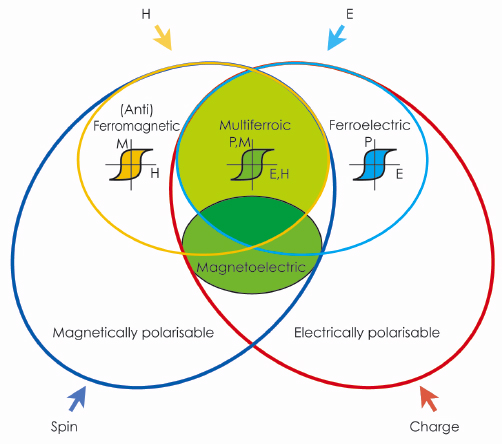- Home
- Users & Science
- Scientific Documentation
- ESRF Highlights
- ESRF Highlights 2009
- Electronic structure and magnetism
Electronic structure and magnetism
In the past few years there has been a large increase in interest in materials exhibiting more than one type of ferroic order e.g. ferromagnetism, ferroelectricity, etc. [1]. The field of multiferroics has become important for both a basic understanding of the interaction between, for example, magnetic and electric coupling and the potential use of such materials in devices. Indeed, one could imagine the switching of magnetic states using an electric field or vice versa. These applications give us magnetoelectronic devices [2].
Although there are many magnetic and ferroelectric materials, there are relatively few multiferroic materials, since the conditions for co-existence of several types of order are stringent (see Figure 79) [3]. Typical materials showing such properties are perovskite transition metal compounds including for example TbMnO3, HoMn2O5, LuFe2O4, bismuth compounds like BiFeO3, etc. [4,5]. There are two types of multiferroics; proper (or type I) where the electric and magnetic properties occur for different reasons, but are coupled together e.g. BiFeO3; and improper (or type II) multiferroics where both orders are deeply coupled e.g. TbMnO3. The latter are of fundamental interest but not of practical use today due to their low critical parameters and the former represent the main area for future applications. There is active research to understand both classes of multiferroics [6]. Consequently, it is not surprising that many of the Highlight articles this year represent investigations in the area of multiferroics and probe many different aspects of the problem.
In common with the studies of multiferroics there are also many other research efforts today to tailor the properties of materials. This is both to increase our understanding of matter and to open up new possibilities for engineering materials with new properties. Whether this be in the control of magnetic anisotropy in molecular magnets [see P. Gambardella et al.], generating a metallic behaviour at the interface between two insulators [see M. Salluzzo et al.] or in the magnetic properties of nanoparticles made of non-magnetic atoms [see J. Bartolomé et al.], the common theme is exploring and understanding new phenomena.
 |
|
Fig. 79 : Multiferroic materials combine magnetic and ferroelectrical properties. |
References
[1] N.A. Spaldin and M. Fiebig “The Renaissance of Magnetoelectric Multiferroics”, Science 309, 391 (2005).
[2] M. Bibes and A. Barthélémy, Nature Materials 7, 425 (2008).
[3] For example: D. Khomskii “Classifying multiferroics: Mechanisms and effects”, Physics 2, 20 (2009).
[4] T. Kimura et al., ”Magnetic control ferroelectric polarization”, Nature 426, 55 (2003).
[5] J. Wang et al., ”Epitaxial BiFeO3 Multiferroic Thin Film Heterostructures”, Science 299, 1719 (2003).
[6] For example: special issue, J. Phys. Condens. Matter 20, 434201-434220 (2008).



